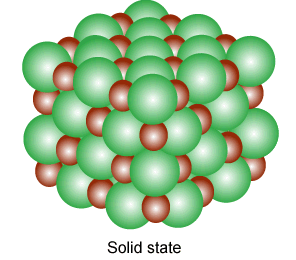Find the packing efficiency of silver metal?
Find the packing efficiency of silver metal?
Solution and Explanation
The packing efficiency of a metallic crystal is defined as the ratio of the volume occupied by the atoms in the unit cell to the total volume of the unit cell.
For face-centered cubic (FCC) metals like silver (Ag), the packing efficiency is given by:
Packing Efficiency:
\[
\text{packing efficiency} = \frac{4 \times (\text{volume of one atom})}{\text{volume of the unit cell}}
\]
The volume of one atom is calculated using its atomic radius (144 pm for silver):
\[ \text{volume of one atom} = \frac{4}{3} \times \pi \times (144 \text{ pm})^3 = 2.52 \times 10^{-23} \text{ cm}^3 \]
The unit cell volume in an FCC lattice is:
\[ a = \frac{2 \times 144 \text{ pm}}{\sqrt{2}} = 408.3 \text{ pm} = 4.083 \times 10^{-8} \text{ cm} \]
\[ \text{volume of unit cell} = \frac{a^3}{4} = 6.21 \times 10^{-24} \text{ cm}^3 \]
Finally, the packing efficiency is:
\[ \text{packing efficiency} = \frac{4 \times 2.52 \times 10^{-23}}{6.21 \times 10^{-24}} = 0.74 \]
Thus, the packing efficiency of silver is approximately 74%.
Top Questions on The solid state
- A metal crystallizes in simple cubic lattice. The volume of one unit cell is \( 6.4 \times 10^{-7} \, \text{pm}^3 \). What is the radius of the metal atom in pm?
- AP EAPCET - 2025
- Chemistry
- The solid state
- A metal crystallises in two cubic phases, fcc and bcc with edge lengths 3.5 Å and 3 Å respectively. The ratio of densities of fcc and bcc is approximately
- TS EAMCET - 2025
- Chemistry
- The solid state
- How many kinds of Bravais lattice are possible in a crystal?
- Bihar Board XII - 2025
- Chemistry
- The solid state
- The percentage of free space in a body-centred cubic unit cell is
- Bihar Board XII - 2025
- Chemistry
- The solid state
- Which of the following is not a crystalline solid?
- Bihar Board XII - 2025
- Chemistry
- The solid state
Concepts Used:
Solid State
Solids are substances that are featured by a definite shape, volume, and high density. In the solid-state, the composed particles are arranged in several manners. Solid-state, in simple terms, means "no moving parts." Thus solid-state electronic devices are the ones inclusive of solid components that don’t change their position. Solid is a state of matter where the composed particles are arranged close to each other. The composed particles can be either atoms, molecules, or ions.

Types of Solids:
Based on the nature of the order that is present in the arrangement of their constituent particles solids can be divided into two types;
- Amorphous solids behave the same as super cool liquids due to the arrangement of constituent particles in short-range order. They are isotropic and have a broad melting point (range is about greater than 5°C).
- Crystalline solids have a fixed shape and the constituent particles are arranged in a long-range order.